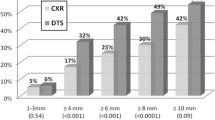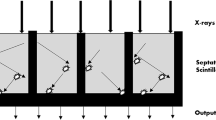Abstract
Objective
To assess the impact of digital tomosynthesis (DTS) on the radiological investigation of patients with suspected pulmonary lesions on chest radiography (CXR).
Methods
Three hundred thirty-nine patients (200 male; age, 71.19 ± 11.9 years) with suspected pulmonary lesion(s) on CXR underwent DTS. Two readers prospectively analysed CXR and DTS images, and recorded their diagnostic confidence: 1 or 2 = definite or probable benign lesion or pseudolesion deserving no further diagnostic workup; 3 = indeterminate; 4 or 5 = probable or definite pulmonary lesion deserving further diagnostic workup by computed tomography (CT). Imaging follow-up by CT (n = 76 patients), CXR (n = 256) or histology (n = 7) was the reference standard.
Results
DTS resolved doubtful CXR findings in 256/339 (76 %) patients, while 83/339 (24 %) patients proceeded to CT. The mean interpretation time for DTS (mean ± SD, 220 ± 40 s) was higher (P < 0.05; Wilcoxon test) than for CXR (110 ± 30 s), but lower than CT (600 ± 150 s). Mean effective dose was 0.06 mSv (range 0.03–0.1 mSv) for CXR, 0.107 mSv (range 0.094–0.12 mSv) for DTS, and 3 mSv (range 2–4 mSv) for CT.
Conclusions
DTS avoided the need for CT in about three-quarters of patients with a slight increase in the interpretation time and effective dose compared to CXR.
Key Points
• Digital tomosynthesis (DTS) improves the diagnostic confidence of chest radiography (CXR)
• DTS reduces the need for CT for a suspected pulmonary lesion
• DTS only imparts a radiation dose of around two CXRs
• DTS takes longer to interpret than conventional chest radiography






Similar content being viewed by others
Abbreviations
- CXR:
-
Chest radiography
- DTS:
-
Digital tomosynthesis
- CT:
-
Computed tomography
References
Wu N, Gamsu G, Czum J et al (2006) Detection of small pulmonary nodules using direct digital radiography and picture archiving and communication systems. J Thorac Imaging 21:27–31
Bley TA, Baumann T, Saueressig U et al (2008) Comparison of radiologist and CAD performance in the detection of CT-confirmed subtle pulmonary nodules on digital chest radiographs. Investig Radiol 43:343–348
Remy-Jardin M, Remy J, Giraud F, Marquette CH (1993) Pulmonary nodules: detection with thick-section spiral CT versus conventional CT. Radiology 187:513–520
Rubin GD, Lyo JK, Paik DS et al (2005) Pulmonary nodules on multi-detector row CT scans: performance comparison of radiologists and computer-aided detection. Radiology 234:274–283
Dobbins JT III, Godfrey DJ (2003) Digital x-ray tomosynthesis: current state of the art and clinical potential. Phys Med Biol 48:R65–R106
Dobbins JT, Mc Adams HP, Devon G, Li CM (2008) Digital tomosynthesis of the chest. J Thorac Imaging 23:86–92
Dobbins JT, Mc Adams HP, Song JW et al (2008) Digital tomosynthesis of the chest for lung nodule detection: interim sensitivity results from an ongoing NIH-sponsored trial. Med Phys 35:2554–2557
Vikgren J, Zachrisson S, Svalkvist A et al (2008) Comparison of chest tomosynthesis and chest radiography for detection of pulmonary nodules: human observer study of clinical cases. Radiology 249:1034–1041
Gomi T, Nakajima M, Fujiwara H, Umeda T (2011) Comparison of chest dual-energy subtraction digital tomosynthesis imaging and dual-energy subtraction radiography to detect simulated pulmonary nodules with and without calcifications a phantom study. Acad Radiol 18:191–196
Yamada Y, Jinzaki M, Hasegawa I et al (2011) Fast scanning tomosynthesis for the detection of pulmonary nodules: diagnostic performance compared with chest radiography using multidetector-row computed tomography as the reference. Investig Radiol 46:471–477
Quaia E, Baratella E, Cioffi V, Bregant P, Cernic S, Cuttin R, Cova MA (2010) The value of digital tomosynthesis in the diagnosis of suspected pulmonary lesions on chest radiography: analysis of diagnostic accuracy and confidence. Acad Radiol 17:1267–1274
Kim EY, Chung MJ, Lee HY, Koh WJ, Jung HN, Lee KS (2010) Pulmonary mycobacterial disease: diagnostic performance of low-dose digital tomosynthesis as compared with chest radiography. Radiology 257:269–277
Hansell DM, Bankier A, Mac Mahon H, McLoud T, Muller NL, Remy J (2008) Fleischner society: glossary of terms for thoracic imaging. Radiology 246:697–722
Servomaa A, Tapiovaara M (1998) Organ dose calculation in medical X ray examinations by the program PCXMC. Radiat Prot Dosim 80:213–219
Cristy M, Eckerman KR (1987) Specific absorbed fractions of energy at various ages from internal photon sources. I. Method. Publication no. ORNL/TM-8381, Oak Ridge National Laboratory, Oak Ridge (USA)
Sabol JM (2009) A Monte Carlo estimation of effective dose in chest tomosynthesis. Med Phys 36:5480–5487
European Guidelines on Quality Criteria for Computed Tomography (1999) Report EUR 16262. European Commission, Brussels. Available at: http://www.drs.dk/guidelines/ct/quality/index.htm
Campbell MJ, Machin D (1999) Medical statistics, a commonsense approach. Wiley, Chichester, pp 85–89
Beck JR, Shultz EK (1986) The use of relative operating characteristic (ROC) curves in test performance evaluation. Arch Pathol Lab Med 110:13–20
Hanley JA, McNeil BJ (1983) A method of comparing the areas under receiver operating characteristic curves derived from the same cases. Radiology 148:839–843
Kundel HL, Polansky M (2003) Measurement of observer agreement. Radiology 228:303–308
Erasmus JJ, Connolly JE, McAdams HP, Roggli VL (2000) Solitary pulmonary nodules. I. Morphologic evaluation for differentiation of benign and malignant lesions. RadioGraphics 20:43–58
Zhu X, Yu J, Huang Z (2004) Low-dose chest CT: optimizing radiation protection for patients. AJR Am J Roentgenol 183:809–816
Gierada DS, Pilgram TK, Ford M et al (2008) Lung cancer: interobserver agreement on interpretation of pulmonary findings at low-dose CT screening. Radiology 246:265–272
Li B, Avinash GB (2007) Optimization of slice sensitivity profile for radiographic tomosynthesis. Med Phys 34:2907–2916
Godfrey DJ, McAdams HP, Dobbins JT (2006) Optimization of the matrix inversion tomosynthesis (MITS) impulse response and modulation transfer function characteristics for chest imaging. Med Phys 33:655–667
Acknowledgments
We thank Dr John Sabol, GE Healthcare, for invaluable help in the VolumeRad dose calculations.
Author information
Authors and Affiliations
Corresponding author
Rights and permissions
About this article
Cite this article
Quaia, E., Baratella, E., Cernic, S. et al. Analysis of the impact of digital tomosynthesis on the radiological investigation of patients with suspected pulmonary lesions on chest radiography. Eur Radiol 22, 1912–1922 (2012). https://doi.org/10.1007/s00330-012-2440-3
Received:
Revised:
Accepted:
Published:
Issue Date:
DOI: https://doi.org/10.1007/s00330-012-2440-3




